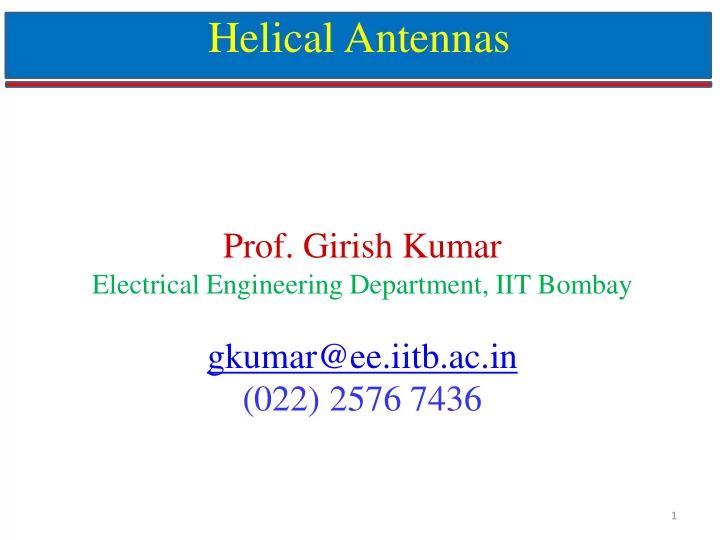

Helical Antennas Prof. Girish Kumar Electrical Engineering Department, IIT Bombay gkumar@ee.iitb.ac.in (022) 2576 7436 1
Helical Antenna L S d D Helix axis C = D S L A = nS Total Length of wire = nL Total axial length (A) = nS Special Cases of Helical Antenna: Case 1: α = 0 ° S = 0 Loop Antenna Case 2: α = 90 ° D = 0 Linear Antenna (Reference: JD Kraus, Antennas, Tata-McGraw Hill, 1988) 2
Modes in Helical Antenna Normal Axial Conical Mode Mode Mode C = π D << λ C ≈ λ C ≈ nλ , n = 2, 3.. 3
Helical Antenna Modes Chart C/ λ Axial Mode Normal Mode S/ λ 4
Field Distribution in Different Modes 5
Axial Mode Helical Antenna: Ground Plane (a) (b) (c) Monofilar Axial Mode Helical Antenna a) Flat Ground Plane b) Shallow Cupped Ground Plane c) Deep Conical Ground Plane Enclosure. 6
Conductor Size of Helical Antenna Monofilar axial-mode helical antennas with wire diameter of 0.055 , 0.017 and 0.0042 at center frequency of 400 MHz Effect of conductor diameter on helical antenna performance - only minor changes 7
Helical Antenna Support 8
Axial Mode Helical Antenna - Input Impedance For Axial Feed: R = 140 * C λ For Peripheral or Circumferential Feed: R 150 / √ C λ Restrictions: (a) 0.8 ≤ C λ ≤ 1.2 (b) 12 ° ≤ α ≤ 14° (c) n 4 9
Input Impedance Matching 1. Tapered Transition from helix to coaxial line w = width of conductor at termination 2. Tapered Microstrip Transition 10
Radiation Pattern of Axial Mode Helical Antenna Measured Field Patterns of Axial Mode Helical Antenna of 6 turns and pitch angle α = 14 ° . CP Radiation Pattern for C/ from 0.73 to 1.22. ( ) Horizontally polarized field component and 11 ( ) Vertically polarized.
Effect of No. of Turns (n) Helical Antennas: α =12.2° and 10, 8, 6, 4, 2 turns. 12
Pattern of Single Turn Helical Antenna 13
Axial Mode Helical Antenna - Increased Directivity Endfire Array 14
Gain of Axial Mode Helical Antenna HPBW (Half-Power Beamwidth) BWFN (Beamwidth Between First Nulls) Directivity = 32,400 / HPBW 2 Gain = η x Directivity, η ≈ 60% 15
Design of Axial Mode Helical Antenna Desired: Directivity = 24 dB = 251.19 For Axial Mode Helical Antenna: Assume: C λ = 1.05 ( 0.8 to 1.2) α = 12.7 ° (12 ° to 14 ° ) Calculate: S λ = C λ tan α = 0.2366 16
2x2 Helical Antenna Array Instead of single 80-turns helical antenna, four 20- turns helical antennas can be used Directivity of each 20-turns helical antenna = 251.19/4 = 62.8 dx Effective Aperture dy Assuming Square Aperture Side Length = 5 λ = 2.236 λ 2x2 Array Each Helix is placed at the center of its aperture. 17
Helical Antenna and Arrays Front View Side View n = 80 1 Helix 2.236 λ n = 20 4 Helices 18
Arrays of Helical Antenna Front View Side View 1.49 λ n = 9 9 Helices 1.18 λ n = 5 16 Helices 19
Mutual Impedance between Arrays of Helical Antennas Resistive (R) and Reactive (X) components of the mutual impedance of a pair of same-handed 8-turn axial-mode helical antennas of 12 ° pitch angle 20
2x2 Array of Helical Antenna at 800 MHz 21
Results of 2x2 Array of Helical Antenna Directivity = 18.5 dB at 800 MHz 22
Helix as a Parasitic Element Helix-Helix Polyrod-Helix LP to CP Corner-reflector Helix, LP to CP Horn-Helix LP to CP Helix Lens Helix-Helix More Gain 23
Normal Mode Helical Antenna D D Small Dipole: jkr S kI Se S o E j sin 4 r Small Loop: 2 D jkr k I e 2 o 2 E sin 4 r Therefore, Axial Ratio is: E 2 S 2 S AR 2 2 E C C For Circular Polarization, AR = 1 2 C S 24
Design of Normal Mode Helical Antenna For Infinite Ground Plane: Wire length ≈ λ / 4 – text book > λ / 4 – in reality Radiation Resistance (R s ) 2 Iav 1(790) 2 R h R 0.6 s Io s 2 Axial Ratio (AR) 2 AR = 2 S λ / C λ = 2x0.01/0.04 2 = 12.5 = 21.94 dB Feed is tapped after one turn for impedance matching 25
Normal Mode Helical Antenna on Small Circular Ground Plane 26
Effect of Ground Plane Size on NMHA As ground plane radius increases from λ/30 to λ/20, resonance frequency decreases and the input impedance curve shifts upward. NMHA designed for 1.8 GHz and r wire = 1.6 mm ( λ/100 ) 27
Effect of Wire Radius on NMHA As radius of wire decreases from λ/80 to λ/120, its inductance increases so resonance frequency of NMHA decreases and its input impedance curve shifts upward (inductive region). NMHA designed for 1.8 GHz and r g = 5.5 mm ( λ/30 ) 28
Effect of Wire Radius on Bandwidth of NMHA 29
Fabricated NMHA on Small Ground Plane and its Results 30
Recommend
More recommend